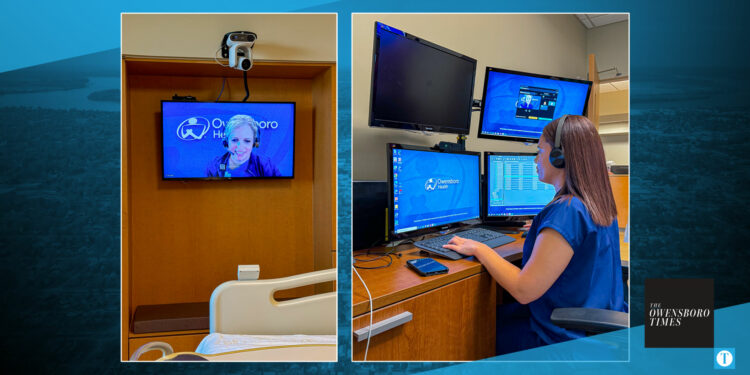Owensboro Health Regional Hospital has launched a virtual nursing program aimed at providing better patient care. The program includes adding a virtual nurse — who is on-site and hospital-employed — to the care team to assist with administrative processes, double-check medication dosages, monitor vital signs, and more.
“We’re excited about this program,” said OH Chief Operating Officer Beth Steele. “It really displays our core commitment of innovation. I think one of the things that is so exciting is the work that went into this. I believe we’ve built a best-in-class virtual nursing model. We’ve studied a lot of other models from across the country and other states, and I think we brought the best of the best to Owensboro.”
A video presentation on Thursday gave an overview of the virtual nursing program.
“Virtual nurses are here to empower our bedside nurses and enhance patient care. Our dedicated virtual nurses work on site ensuring all calls are completely private and secure. They handle crucial administrative tasks like admission, procedure checklists, second nurse signoffs, patient education, family communication, and more,” the video said.
It continued, “Virtual nurses free up precious time for bedside nurses by taking on specific tasks. This means the primary nurse can focus more on providing hands-on care, responding to call lights promptly, and spending quality time with patients. It’s a win-win situation for patients and our nursing staff, reducing workload and increasing satisfaction.”
Patient rooms in the participating units are equipped with cameras, enabling two-way video calls between the virtual nurses and patients. The bedside nurse and physicians can easily connect with the virtual nurse by pressing a button in the room.
When a virtual nurse calls the patient’s room, the TV screen will announce an incoming call and a brief delay will occur before the video connects.
The cameras are only on when a call is taking place. A blue light will also come on to indicate when the video feed is live, and the light will go off and the camera will point toward the ceiling once it’s turned off.
While on, the virtual nurses can control which direction the camera points. The cameras also have a high-quality zoom feature to allow nurses to see small details.
“The cameras that are in the rooms are so good that they can measure in and they can read a small vial of medication,” Steele said. “Those nurses can look at vital signs on the monitor, they can look at the patient very closely and assess them. So even though they’re not in the room, it’s pretty impressive how much detail they can get and how much they can do without having their physical presence there.”
OH Whitney Watson, RN, works in the ortho unit as a hybrid nurse, meaning she spends half her time on the floor taking patient assignments and the other half of the time in the “bunker” — the room where virtual nurses are stationed to take calls to assist the primary nurses.
Watson said one of the most important is doing dual signoffs, when they provide a second verification for the primary nurse to make sure a medication is safe to get to a patient.
“This would include our insulin to make sure the patient’s sugar isn’t too low, blood administration to make sure our patient gets the right kind of blood, and blood thinners by making sure that our platelet count on our patient matches what needs to be done for the medication,” Watson said.
Watson said virtual nurses also do “a lot of behind-the-scenes work” to make workflows more efficient. She said she recently benefited during a shift on the floor by getting some assistance from a virtual nurse.
“It’s nice to know that I have a nurse to delegate tasks to to help me on the unit,” she said. “I’ve never really had that before in a hospital. Usually, you just have a tech on the floor with you, and there are some nursing assignments that they can’t do for me, so that was really helpful.”
OHRH Chief Nursing Officer Joni Simms highlighted that patients can feel comforted in knowing the virtual nurses are not working remotely and are invested in patient care.
“Our virtual nurses are active members of the care team. They are team members at Owensboro Health and they do work here on site,” she said.
Simms also reiterated that there are several responsibilities that are required of a nurse but don’t require one to be physically present.
“If the virtual nurse does all of those tasks, that can give up to about 30-90 minutes per day back to the (primary) nurse,” Simms said.
Steele said OHRH went live with virtual nursing in their ortho/neuro/medical unit and pulmonary unit about 2.5 months ago.
“We chose to do just two units to start just so that we can better understand how it’s working, what’s going well, what’s not going well, and we can actually see how we’re improving as we go,” she said. “Our goal was to get these two units up and running. We want to make sure that our workflows are good. We want to make sure that we’re improving where we thought we were before we (add units) anywhere else.”
Steele said they will review metrics from the third and fourth quarters of this year to start plotting out which units to add next.
She said, “I think it’s going to transform how we do nursing care for the future.”



